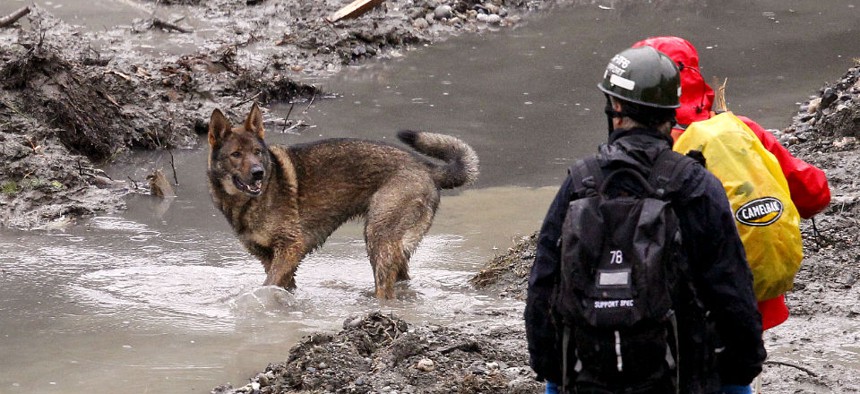How Robots and Dogs May One Day Work Together to Save Your Life

A search dog stands in a water and looks back at handlers at the scene of a deadly mudslide in Oso, Wash. Elaine Thompson/AP
Federal initiative seeks to spur technology to integrate Internet-connected things.
Imagine a disaster -- an earthquake, say. Cellular signals and Wi-Fi have been wiped out, so first responders deploy hotspot-mounted drones. An app on your phone connects to the emergency network directly or via a daisy chain of nearby devices. You can now report your situation and needs.
A command center takes in data from you and other app users, as well as from a team of search dogs wearing a variety of sensors, including cameras, microphones, gas sensors, GPS, Geiger counters and physiological monitors to gauge the animals’ own heart rates and states of being.
When a gas leak is detected, operators send in a haptic robotic arm to cut the flow via a joystick-like controller. Humanoid robots, meanwhile, are rescuing people trapped in a burning building.
This is the vision of the Smart Emergency Response System designed by a team of academics and private companies as part of the Smart America Challenge, a federal effort launched in December by participants in the Presidential Innovation Fellows program to spur the technology behind cyber-physical systems and the Internet of things.
“Cyber-physical systems are integrated hybrid networks of cyber and engineered physical elements,” federal Chief Technology Officer Todd Park explained Wednesday. “These cyber and physical elements come together like peanut butter and jelly to make a really tasty sandwich.”
A demo of the emergency response system, which is still in development, was on display along with 23 other projects at the Smart America Challenge Expo in Washington.
“Some parts of this already existed as separate projects,” Park said of the response system. “But the nine organizations are now working as a collaborative Smart America team, and they found new ways to integrate and expand the system.”
Park touted the societal gains this new technology will make possible. “We believe that these 24 projects demonstrate that cyber-physical and Internet of things can provide concrete, significant, growing socioeconomic benefits that create jobs and business opportunities,” he said. “They can boost American competitiveness, they can improve our health, our environment, our quality of life, and they can increase our resilience in the face of disasters.”



